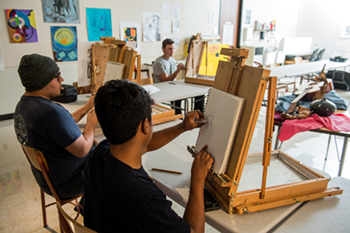Despite fears that the liberal arts are on the ropes, humanities and liberal arts education is not in decline in public colleges in the United States, according to analysis from the Community College Research Center (CCRC) at Columbia University.
The center’s findings have determined that overall, the number of undergraduate liberal arts degrees awarded has risen since 2000, with increases at both two-year and four-year public colleges. Humanities and liberal arts are a vital component of postsecondary education. Coursework in these fields enhances students’ skills as writers, communicators and thinkers while providing direct skills for employment.
At Northeast Community College, the Humanities, Arts and Social Sciences division includes a number of programs - from criminal justice to music to English to human relations to geography/history to psychology/sociology.
Division Dean Faye Kilday said during such time of uncertainty, the arts and humanities are more vital than ever.
“We at Northeast have a responsibility to ensure our students are well prepared for their future careers and are productive citizens,” Kilday said. “The current social, cultural, economic, and political challenges our students face every day make it critical that we provide an opportunity for students to explore their own beliefs, learn from historical lessons, use creativity to express themselves, and learn to develop innovative solutions in order to think critically.”
CCRC researchers found that academic success in liberal arts coursework at a community college is a strong predictor of success after students transfer to a four-year college. One researcher said liberal arts coursework is at least as good as non-liberal arts coursework in predicting four-year college outcomes.
“The humanities and liberal arts - measured by degrees awarded, majors, or course enrollments - remain a large, robust part of the U.S. postsecondary sector. If these fields are in crisis, so must be all college education,” said Clive R. Belfield, one of the report’s authors.
Belfield and his collaborators said the report demonstrates community college students who earn higher grades in humanities and liberal arts courses are more likely to transfer to a four-year college, perform well in humanities and liberal arts courses there, and complete bachelor’s degrees than students who earn lower grades.
“Arts and humanities provide much needed windows to worlds that are different from our own,” said Adam Peterson, speech instructor/director of theatre at Northeast. “Through the study of stories that are unfamiliar, we can study and explore diverse productions, leading to exposure, familiarity, and finally an understanding of those who may be different from ourselves. By witnessing these stories, we can see more clearly that people are just people, trying to live their best lives in their given circumstances, regardless of where they come from.”
Peterson, who earned a Master in Fine Arts in Theatre Directing from East 15 Acting School in London, with additional studies at The Russian Academy of Fine Arts in Moscow and The Indonesian Institute of Art in Bali, said theatre serves as a perfect melting pot for so many different artistic disciplines.
“From poets to painters, and musicians to builders, everyone can use their unique artistic voice collaboratively to create a product that can be shared with a wide array of audiences,” he said. “Despite the conflict that might arise from so many different perspectives in the same room, participants learn to love and respect perspectives different from their own. It becomes more about the process than the end product. As we say in the theatre department, you have to learn to ‘communicate art, not self.’”
In addition to theatrical performances, Northeast’s Humanities, Arts and Social Sciences division hosts over a dozen concerts, recitals, visiting writers, and other cultural events annually. Student accomplishments are celebrated each spring at Northeast's Annual Arts Night where their artwork, scenic designs, vocal/instrumental ensembles, and poetry/short stories are showcased. Northeast's student publication, Voices Out of Nowhere, is also unveiled as part of the celebration.
Kilday said the division’s faculty have met the challenges of trying to host cultural events and performances during a pandemic head on.
“The Visiting Writer's Series,” she said, “has moved to a virtual collaboration with Wayne State College. Local and national poets and authors have performed readings via Zoom while providing the opportunity for very conversational real-time discussions with students and community members. Musical performances and theatre productions are also being moved online this fall to provide students the opportunity to perform.”
The number of humanities and liberal arts degrees awarded annually by community colleges has risen 88% between 2000 and 2015 - from 218,000 to 410,000.
Kilday said it is reflective of the value of arts and humanities in people’s lives.
“As a parent of teenagers, I know first-hand how important the arts and humanities are in preparing my children to tackle the world head on. It’s not just about learning the skills to perform a task. It’s also about learning to be an effective communicator, work in a team, create innovative solutions, and be globally aware. Our world is constantly evolving and it will take a balance of all of these essential skills for our children to be successful in life.”
--###--
PHOTO CUTLINE
Students work on a project in an art class at Northeast Community College.

